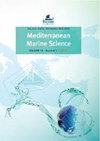利用无人机调查地中海微生境中入侵蓝蟹的生境利用和行为
IF 2.3
3区 环境科学与生态学
Q1 MARINE & FRESHWATER BIOLOGY
引用次数: 0
摘要
蓝蟹Callinectes sapidus已经显示出巨大的能力来适应地中海的新栖息地。在大量关于其在西西里岛西部扩散的报告之后,进行了一项调查,以确定任何现有种群。2021年8月,在特拉帕尼自然保护区发现了一群蓝蟹,该保护区包括大片恢复的盐沼。在这项研究中,通过使用无人机开发跟踪系统,我们研究了(i)蓝蟹的每小时行为,以及(ii)蓝蟹在盐沼中的每周位置,以确定基质偏好。这项研究为更好地了解智齿龙的栖息地利用及其对当地生物多样性的潜在影响提供了一种新的方法。蓝蟹的活动随着温度和潮高的增加而增加,在高潮和最高温度时观察到活动的峰值:在T>28°C时,平均速度(m h-1)高于在T=23.7°C时(2.0±3.2 m h-1。考虑到栖息地的使用,在49±13%的情况下,在沙地上观察到蓝蟹,在Cymodocea草地上观察到21±14%,在Ruppia草地上观察看到30±15%。这些微栖息地为智齿龙提供了避难所,在设计和实施管理计划来管理这种重要的入侵物种之前,应该优先考虑和研究这些微栖息地。本文章由计算机程序翻译,如有差异,请以英文原文为准。
The use of an unmanned aerial vehicle to investigate habitat use and behavior of invasive blue crab in Mediterranean microhabitats
The blue crab Callinectes sapidus has shown an immense capacity to adapt to new habitats in the Mediterranean Sea. Followingthe numerous reports of its proliferation along western Sicily, an investigation was conducted to identify any existing populations. In August 2021, a population of blue crabs was found in the natural reserve of Trapani which includes a large area of restored saltmarshes. In this study, by developing a tracking system using Unmanned Aerial Vehicles (UAV), we studied (i) the behavior of blue crabs on an hourly scale, and (ii) the weekly position of blue crabs in the saltmarshes to determine substrate preference. This study provides a new approach to better understand C. sapidus’ habitat use and their potential impact on local biodiversity. Blue crab activity was found to increase with temperature and tidal height, with a peak in activity observed at high tide and at maximum temperatures: the mean speed (m h-1) was higher (12.1 ± 8.7 m h-1) at T > 28 °C than at T = 23.7 °C (2.0 ± 3.2 m h-1). Considering habitat use, in 49 ± 13 % of the cases, blue crabs were observed on the sand, while 21 ± 14 % in the Cymodocea meadows, and 30 ± 15 % in the Ruppia meadows. These microhabitats provide a refuge for C. sapidus and should be prioritized and studied before management plans are designed and implemented to manage this important invasive species.
求助全文
通过发布文献求助,成功后即可免费获取论文全文。
去求助
来源期刊

Mediterranean Marine Science
MARINE & FRESHWATER BIOLOGY-
CiteScore
5.20
自引率
17.90%
发文量
34
审稿时长
>12 weeks
期刊介绍:
The journal Mediterranean Marine Science (MMS), published by the Hellenic Centre for Marine Research (HCMR), issues three volumes annually. The journal welcomes original research articles, short communications, New Mediterranean Biodiversity records, extended reviews, comments, and Theme sections in all fields of Oceanography, Marine Biology, Marine Conservation, Fisheries and Aquaculture in the Mediterranean area and the adjacent regions. All content is peer reviewed.
 求助内容:
求助内容: 应助结果提醒方式:
应助结果提醒方式:


